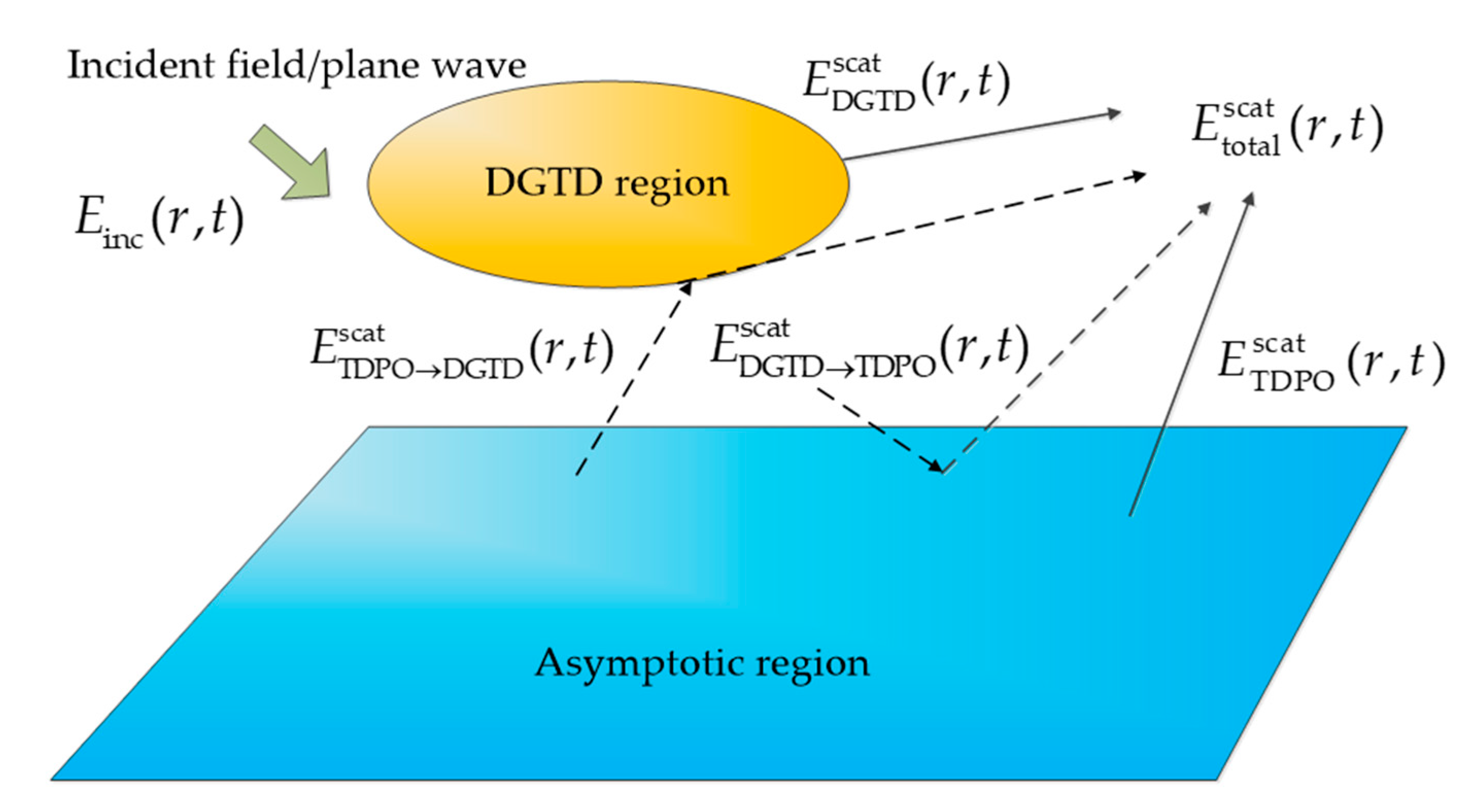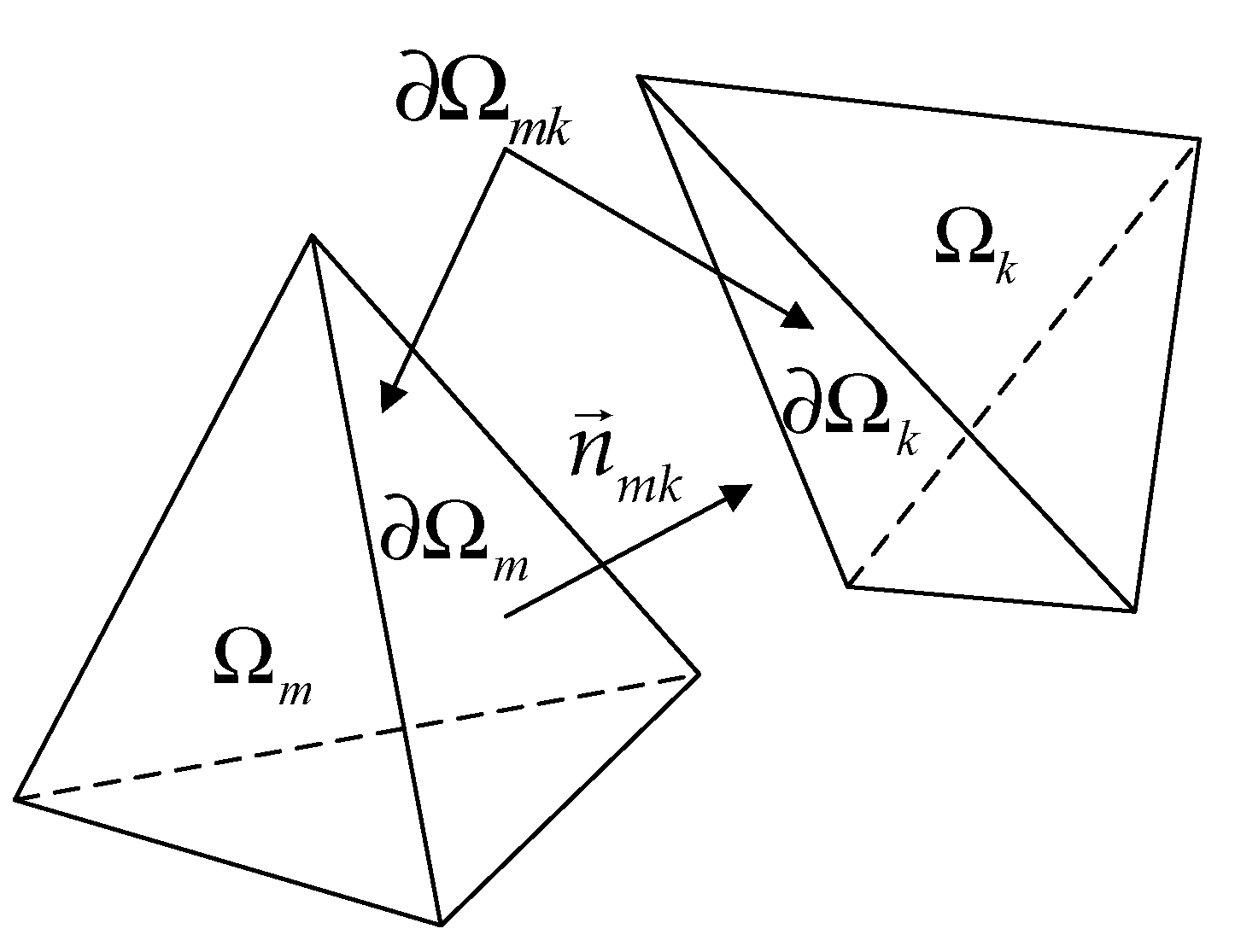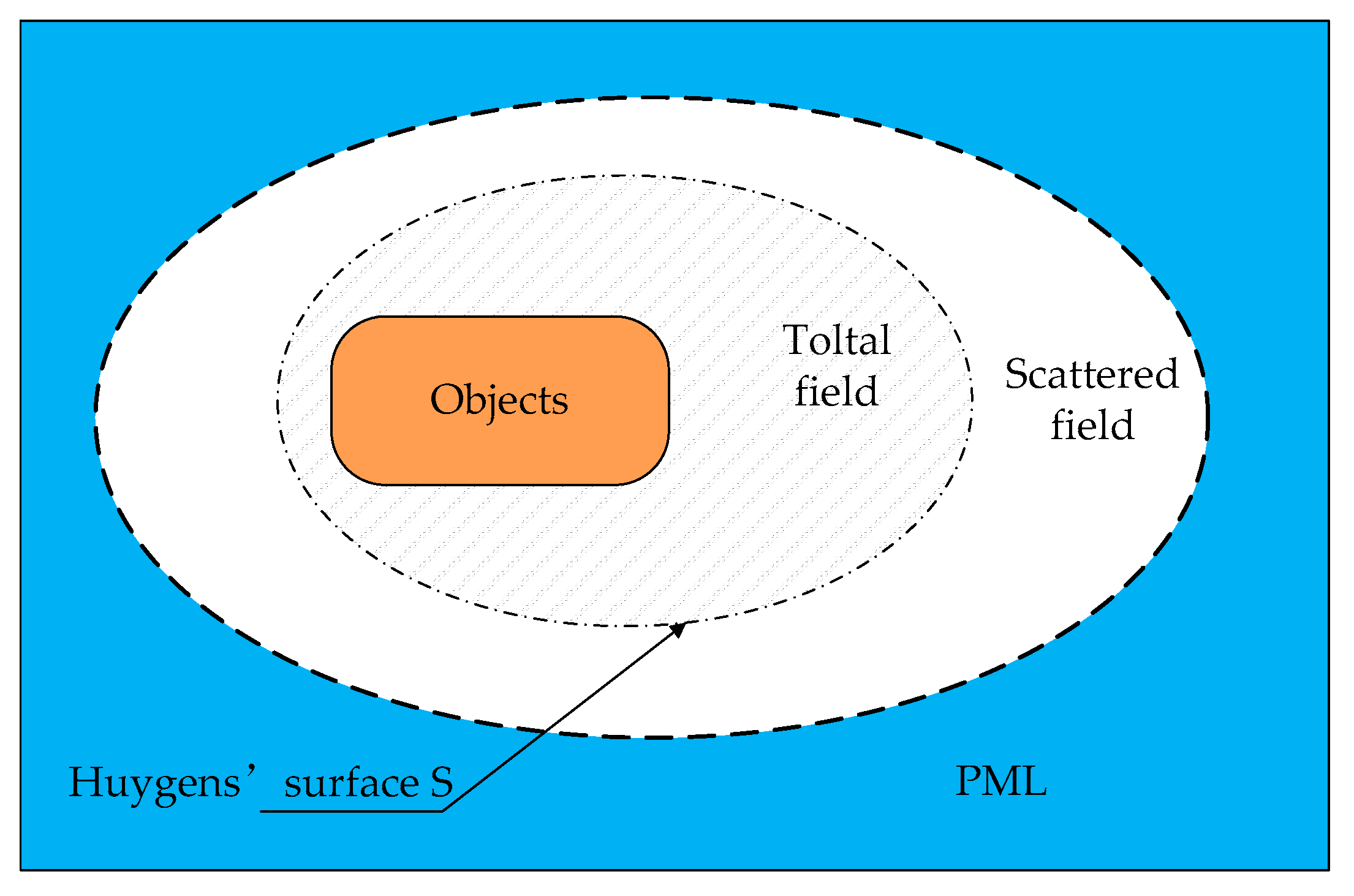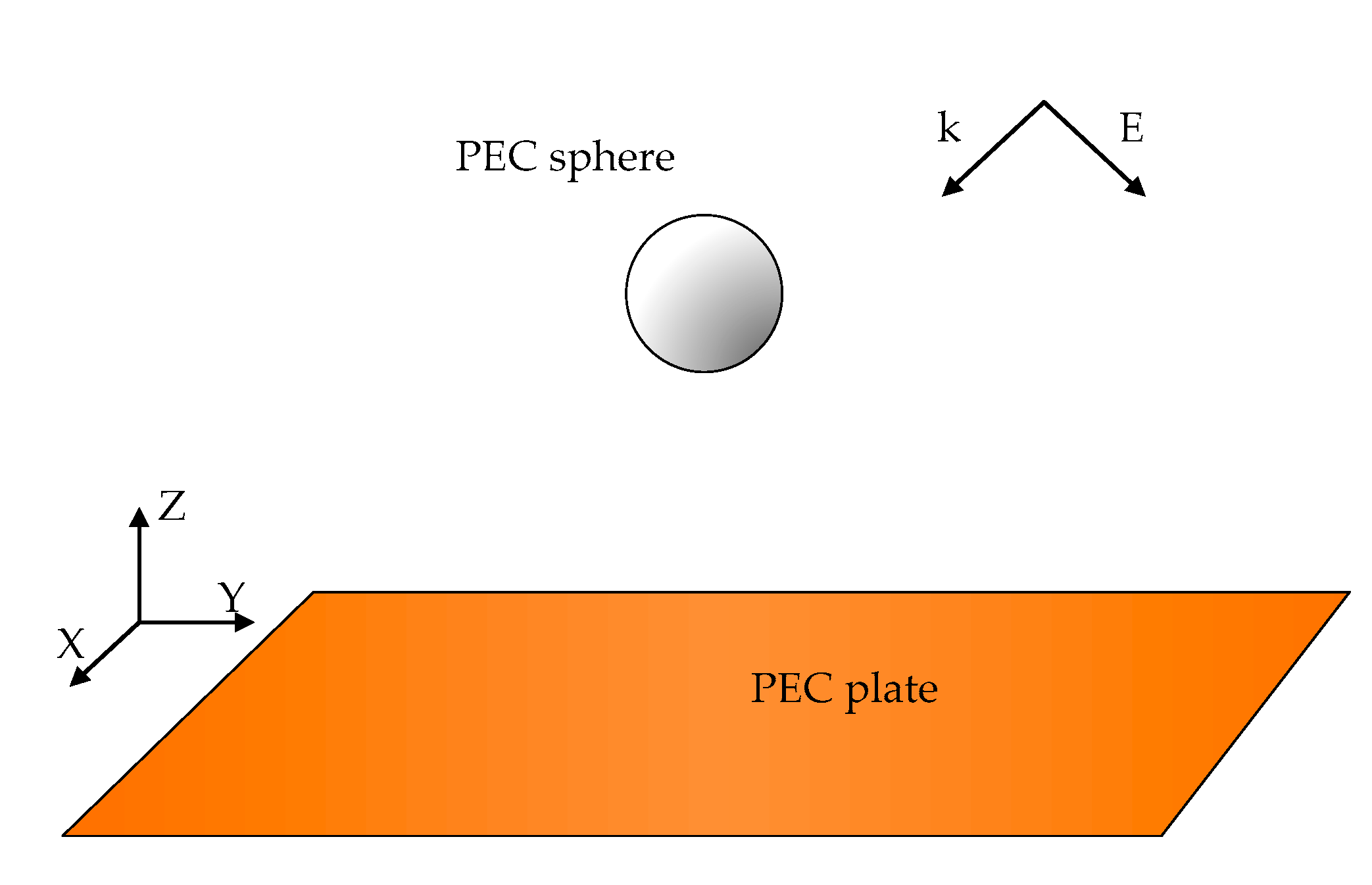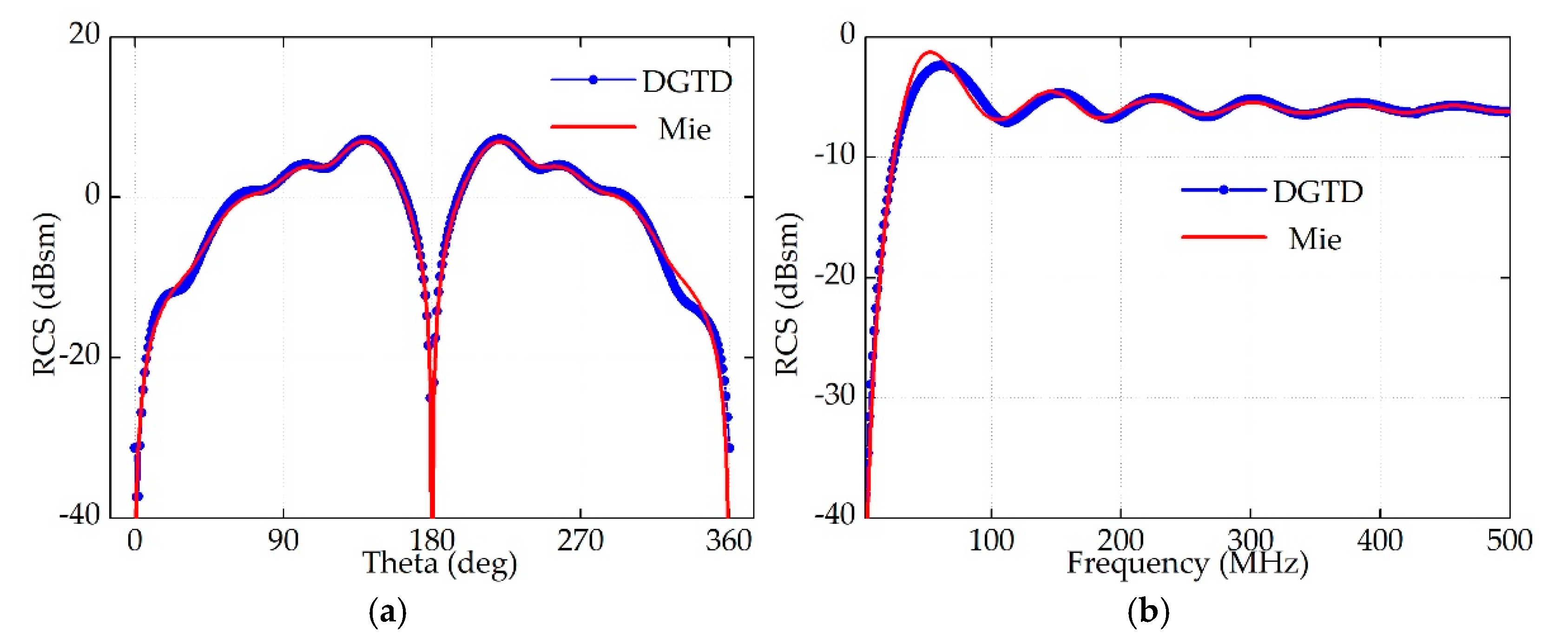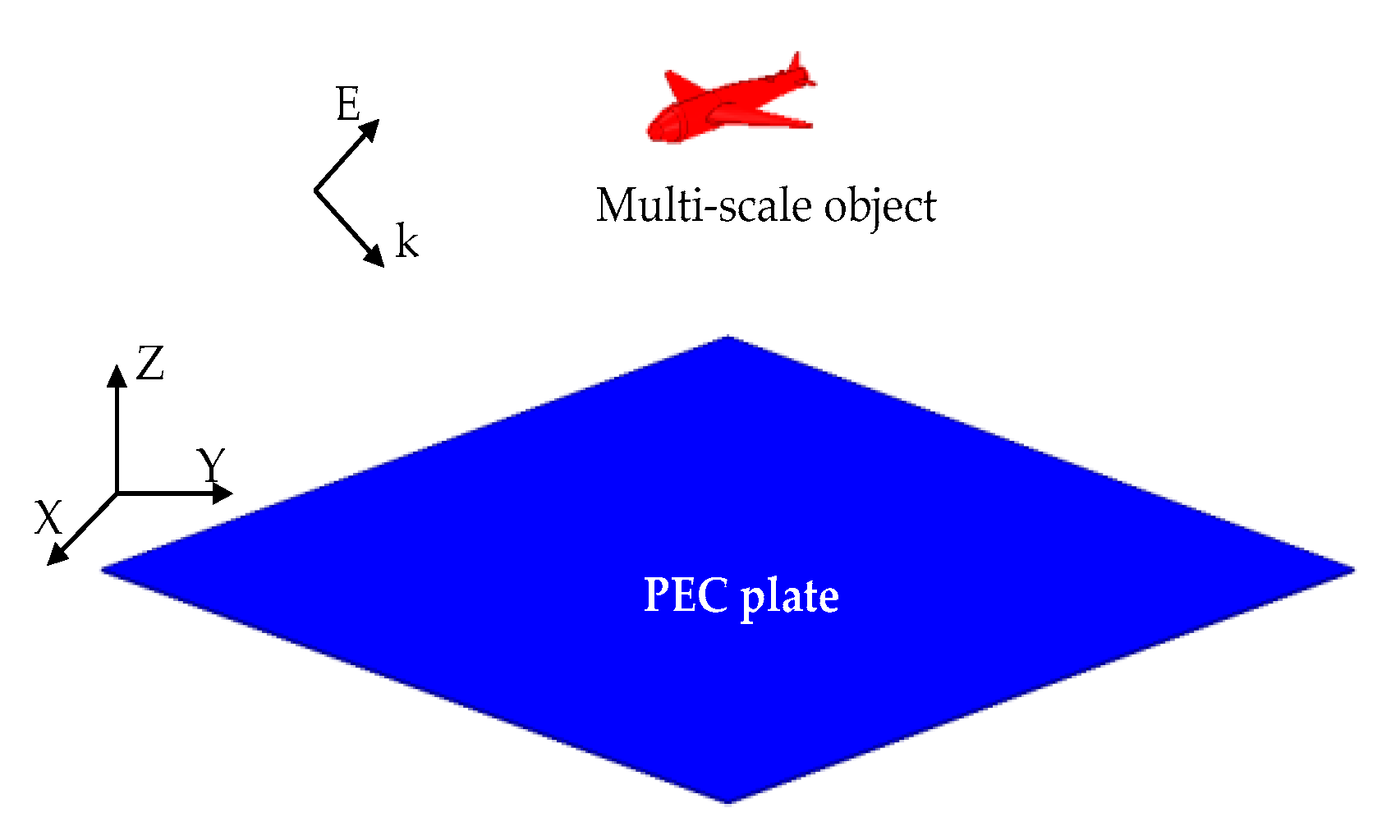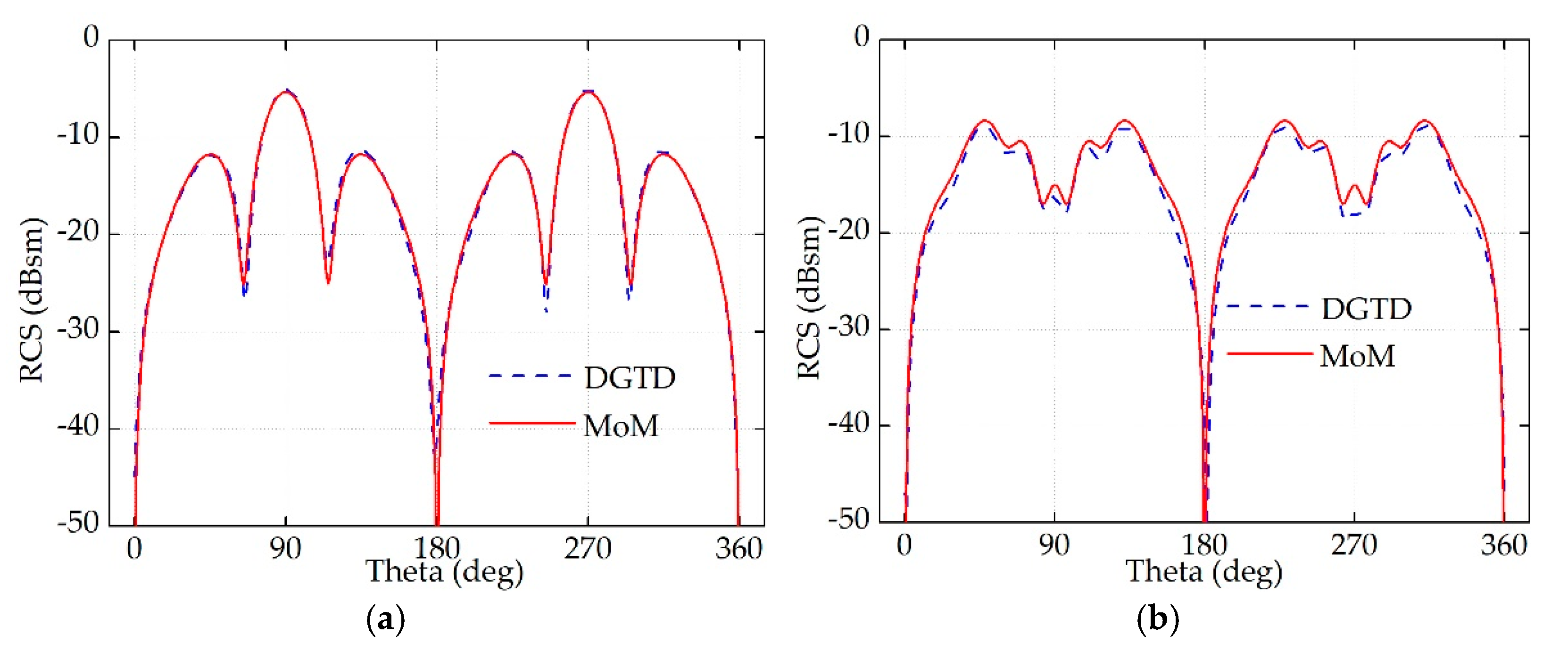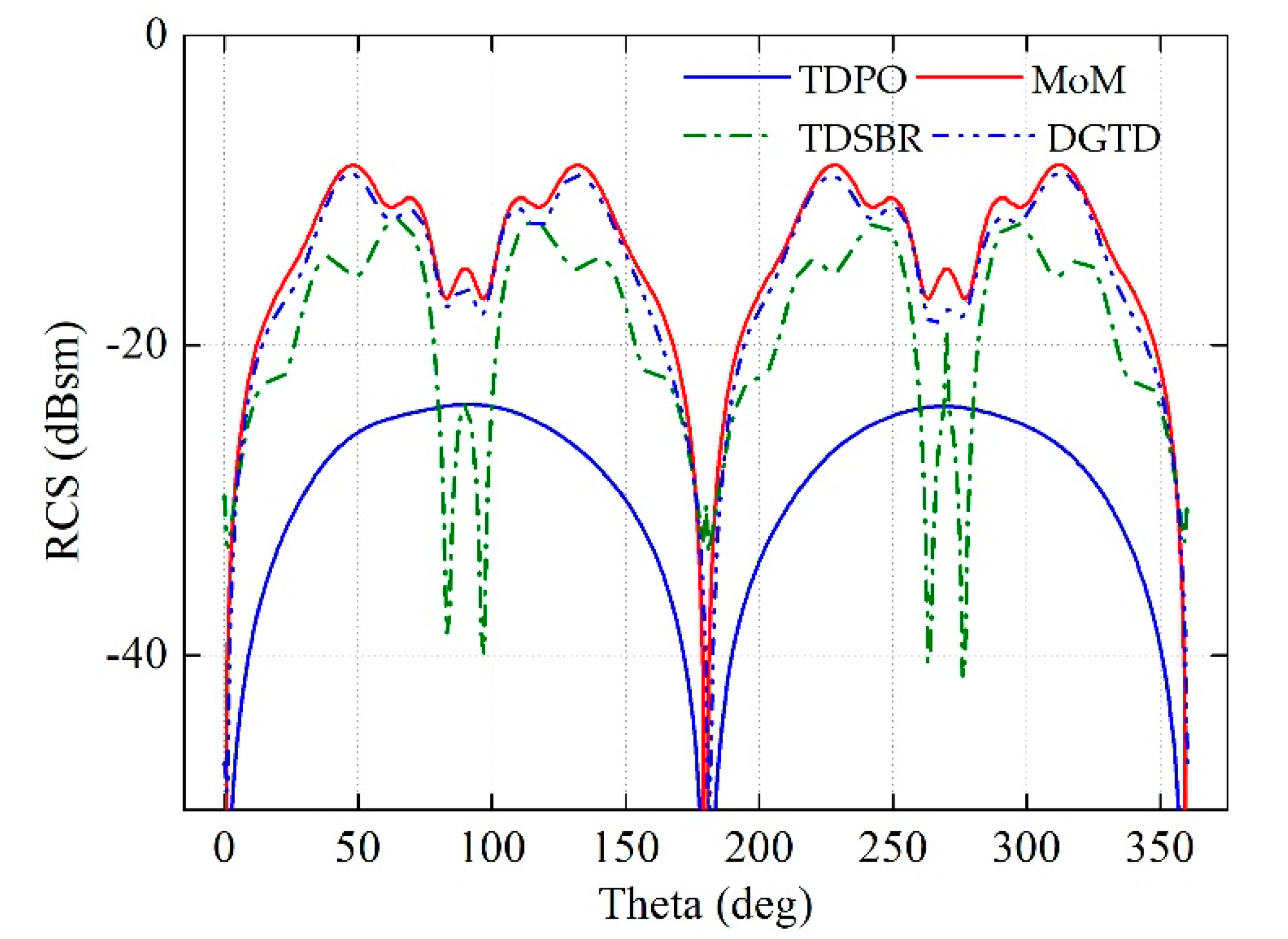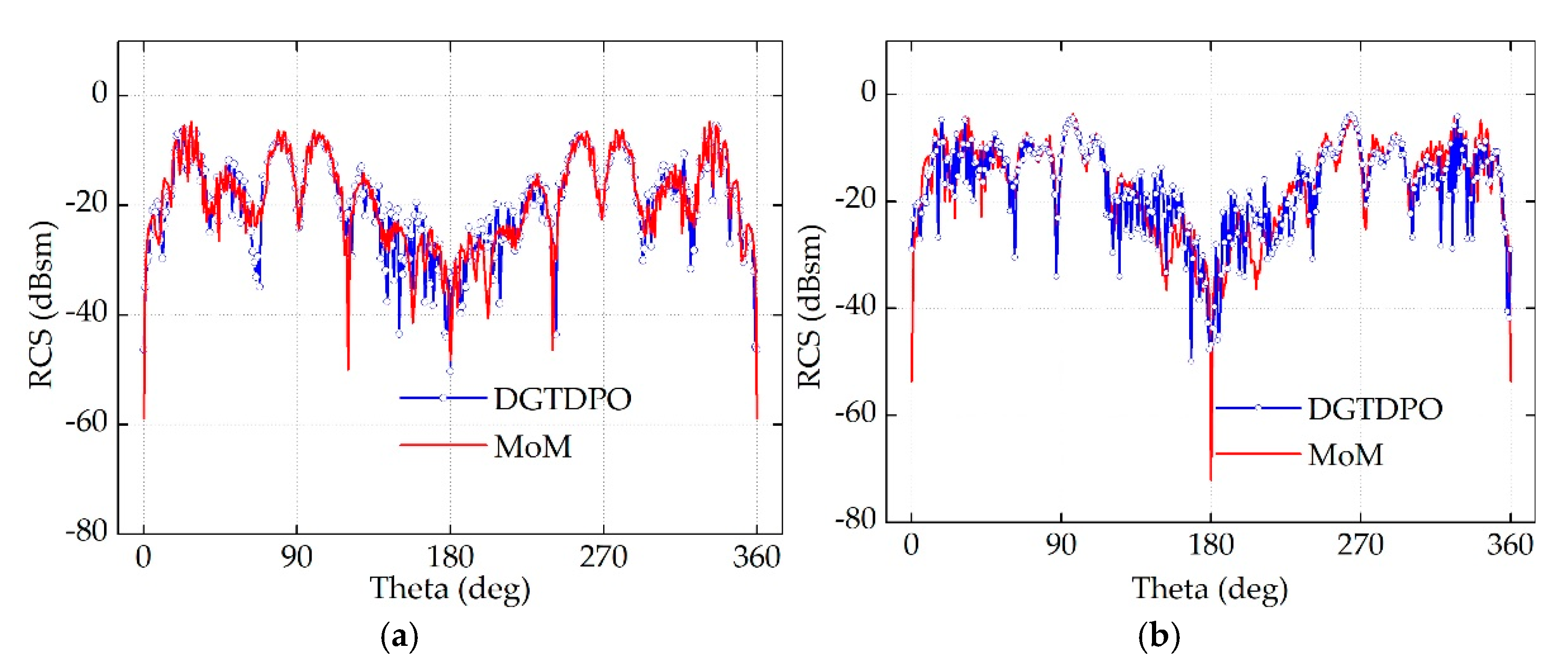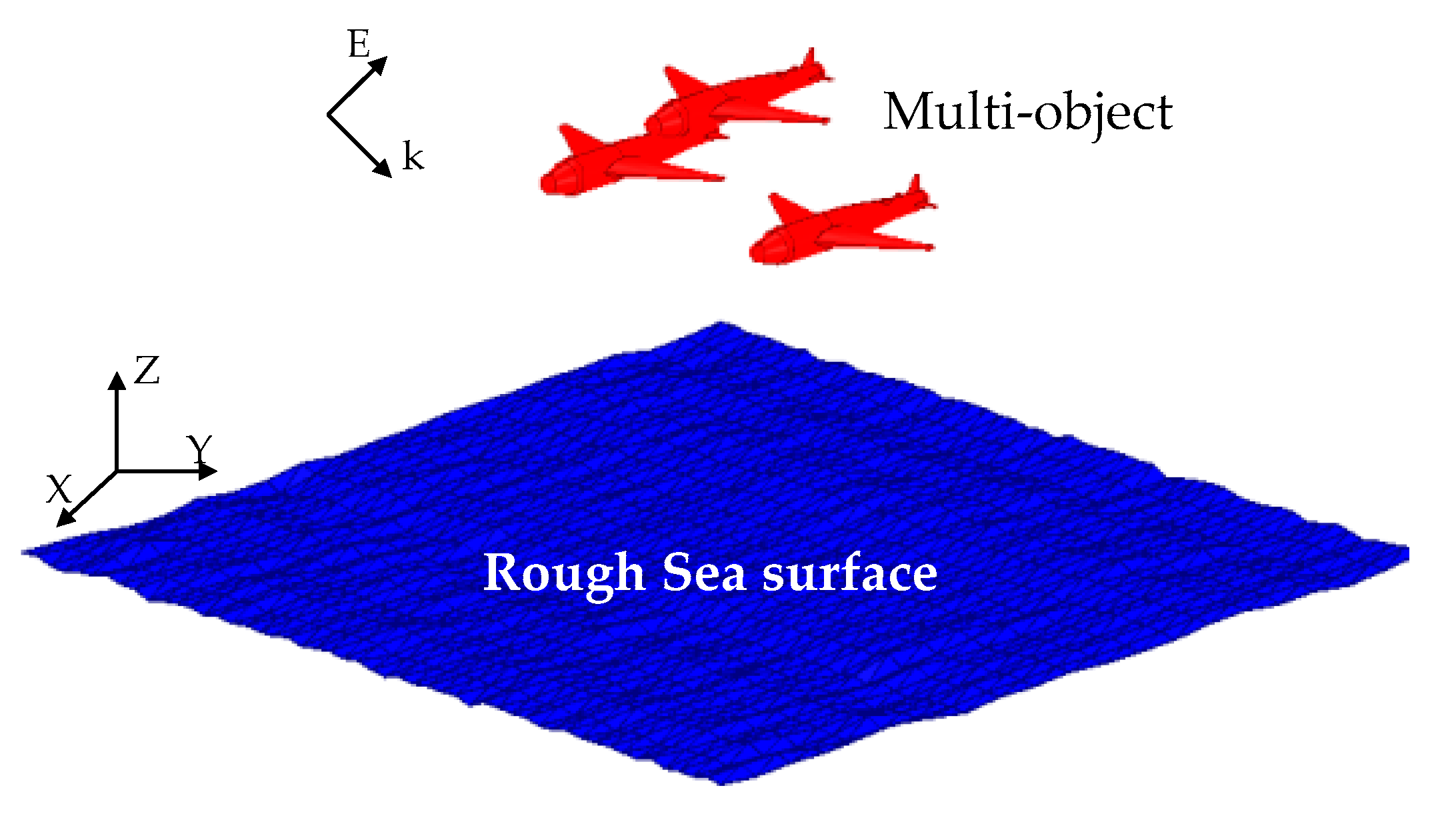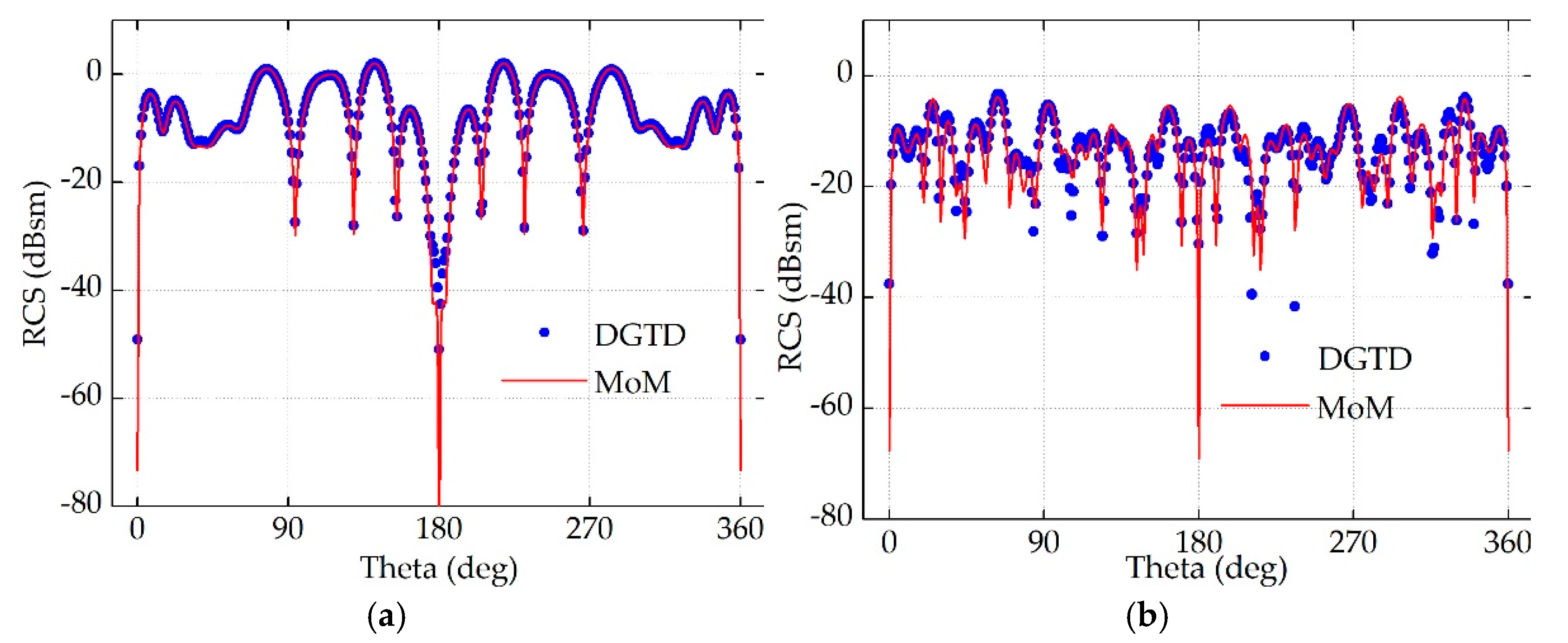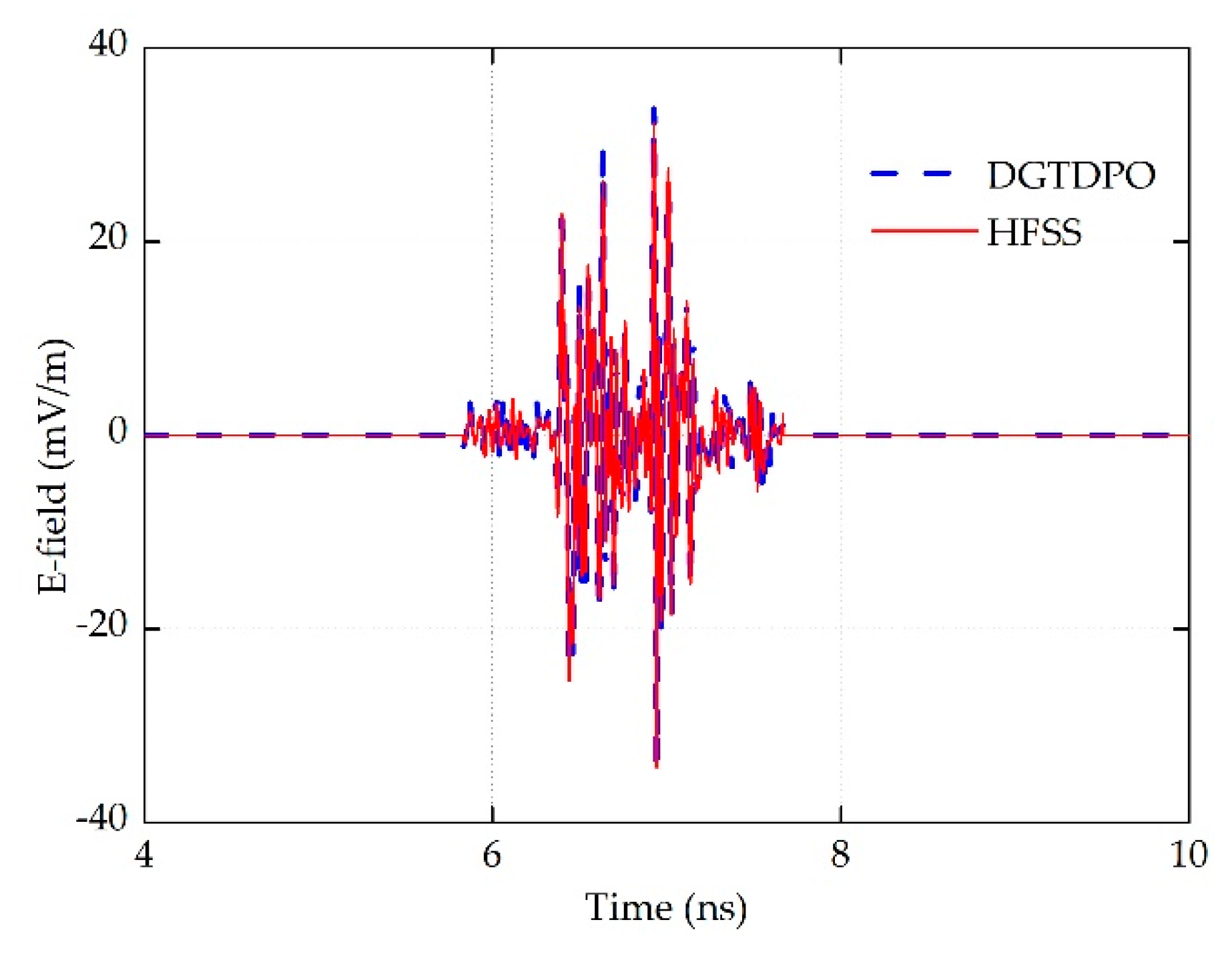1. Introduction
Nowadays, analysis of multi-scale composite transient electromagnetic scattering is an essential part of ocean detection [
1], the reconstructing of the microwave imaging of objects [
2], etc. A scatterer system with complex geometry, multi-scale and multi-object characteristics requires higher calculation accuracy. Moreover, a large-scale environment, such as a rough sea or land surface, will lead to a sharp increase in computing memory and time, and computers cannot keep up. These problems bring challenges to computational electromagnetism.
In order to take into account both accuracy and efficiency, the main method is to mix the full wave method with the high frequency approximation algorithm. In these methods, the full-wave methods, such as the method of moments (MoM), the finite-element time domain (FETD), finite volume time domain (FVTD) and finite-difference time domain (FDTD) calculate the regions with fine structures well. High-frequency algorithms are adopted for the calculation of electrically large areas, so as to improve the calculation speed and reduce the memory costs. Due to the good accuracy of MoM, a class of hybrid methods of MoM and high-frequency approximation algorithms are widely used [
3,
4,
5,
6,
7,
8]. However, the MoM has the problem of low frequency breakdown [
9,
10,
11]. Simultaneously, as a result of the dense matrix, the MoM is slightly inferior to other time-domain algorithms for solving broadband problems in the time domain. Hence, the hybrid method of FDTD and PO was proposed in [
12,
13,
14,
15]. However, due to the ladder error in the calculation of unstructured targets and surface fitting, the accuracy of electromagnetic scattering problem of complex targets had to be improved. Furthermore, the combination of FVTD and PO had also been tried. One paper [
16] discussed the 3D radar cross section (RCS) of a sphere over a plate through FVTD/PO. This method achieves good accuracy for an electrically small sphere; and the larger the electrical size of the plate and the further the asymptotic and FVTD regions are, the higher accuracy of this method is. However, the hybrid method only calculates the frequency domain and does not involve the time domain and multi-scale problems. In addition, according to the conclusion in the literature [
17], the DGTD method requires more time and memory than the FVTD algorithm, but it is able to handle multi-scale structures well; the FVTD method is not suitable for electrically large problems.
In the calculations of the transient scattering of multi-scale targets, a full-wave method named discontinuous Galerkin time domain (DGTD) [
18,
19,
20,
21,
22,
23] has more advantages than other methods in solving broadband multi-scale problems. With respect to geometric modeling, the multi-scale structure can be divided into several subdomains through DGTD. Furthermore, the grid density of each subdomain can be adjusted flexibly. As a result of the uneven tetrahedral grid technology, DGTD is much more accurate than FDTD. Moreover, DGTD is able to divide a large system’s matrix into a group of smaller matrices, which means DGTD is more efficient than FETD at calculating complex structures. In terms of time integration, DGTD can utilize explicit and implicit hybrid schemes in various subdomains and accelerate the solving process [
24]. The flexibility of spatial and temporal discretization makes the DGTD method efficient in multi-scale problems. However, when calculating the complex transient scattering of a complex target above a large area, such as rough sea surface or land through DGTD, the cost in terms of calculations is huge, and the requirement of memory cannot be borne by computers.
With the aim of quickly calculating the transient electromagnetic scattering of electrically large targets, time domain high-frequency techniques, such as time domain physical optics (TDPO) and time domain shooting and bouncing ray (TDSBR), have been developed. These techniques can reduce the burden of memory and improve the calculation speed, greatly. For the TDPO method, the only need is to calculate the induced electromagnetic current on the surface of the target, and then integrate it. Although it is difficult to deal with the multiple reflections [
25,
26,
27,
28], its accuracy is also acceptable if the surface is large enough and located in a far-field region. The TDSBR method combines the advantages of the geometric optics (GO) method and PO method [
29,
30,
31,
32], so the accuracy of TDSBR is better than that of TDPO. However, at least 10 ray tubes per wavelength are needed to build a TDSBR instrument. As the frequency increases, the computational complexity and time required for TDSBR increase. Although the time-domain, high-frequency approximation methods can speed up the solution, their accuracy for complex problems such as multi-scale structures is still poor.
According to the characteristics of the above methods, the DGTD method has more advantages than FDTD, FETD and FVTD in complex geometry modeling, time domain integration and accuracy, and TDPO is simpler and faster than TDSBR. Consequently, in this paper, a hybrid DGTD/TDPO method is proposed to improve the efficiency of the DGTD method in the calculation of transient electromagnetic scattering from multi-scale composite targets. The DGTDPO hybrid method avoids the step error of the FDTD/PO hybrid method when solving unstructured grid problems. At the same time, compared with the MoM/PO hybrid method, this hybrid method can avoid the low frequency breakdown of MoM. In fact, the DGTDPO hybrid method is not only valuable in the area of electromagnetic scattering, but also a great prospect for the study of electrochemical hydrogen evolution [
33], the buckling and flexural vibration analysis of plates with intermediate supports [
34] and the nonlinear vibration of fluid flow in single-walled carbon nanotubes [
35].
In this work, a discontinuous Galerkin time domain solver (DGTD) is hybridized with the TDPO method for the first time to analyze transient multi-scale and composite objects’ scattering problems. The proposed hybrid method possesses the advantages of both DGTD and TDPO. Numerical results demonstrate that the accuracy and efficiency of the proposed method are good enough in various scattering scenarios. The paper is organized as follows. The formulations of DGTDPO hybrid method are reported in
Section 2. Numerical results aimed at validating the advantages of proposed hybrid method for multi-scale and multi-targets composite transient electromagnetic scattering are provided in
Section 3. Finally, conclusions are drawn in
Section 4.
2. Formulation of the Hybrid Method
As shown in
Figure 1, the whole solution domain consists of two parts: the exact solution region (DGTD region) and the asymptotic domain (TDPO region). In the first region, a multi-scale and multi-object complex region is defined. As a result of the complex structure and requirements of higher precision in the first region, the DGTD method is adopted. TDPO is used to calculate the scattering field generated by asymptotic region itself and the transient excitation of DGTD region in the second region, which includes an electrically large plate or rough sea surface.
The whole computational domain is illuminated through a transient source
. The scattered field of whole region in far-field area is defined as
, and approximately given by the following components:
The first two terms
and
are the primary scattered fields generated from DGTD region and TDPO region, respectively. Nevertheless, both terms do not contain the multiple reflections between two regions. These interactions are included in secondary scattered fields denoted as
and
.
represents the scattered field through the asymptotic region when illuminated through the field generated by the DGTD region. Meanwhile,
is defined as the inverse process of
. Additionally, we assume that the asymptotic region is significantly larger than the DGTD region. At the same time, because with the increase of the distance between two regions, the calculation accuracy will be improved [
16], the distance between the two regions has to be large enough.
2.1. Scattered Field Generated by the DGTD Region
The primary scattering contribution from the DGTD region is computed by using the DGTD method. Let be the calculation area enclosing a scatterer, and the unitary outward normal to its boundary . Define as a discretization of ; consists of non-overlapping tetrahedral elements, and , where is the number of mesh elements.
As shown in the
Figure 2, the inner surfaces of the discretization are denoted by
;
are adjacent cells of
, and
is defined as the unit vector normal to the surface
oriented from
toward
.
Applying the discontinuous Galerkin testing to Maxwell curl equations in
yields [
20]:
where
,
and
are the permittivity, permeability and conductivity of the
respectively. In addition,
and
are surface electric current and magnetic current at the interface of adjacent elements, respectively. Moreover,
is the edge basis function of the
m-th tetrahedral element. Meanwhile, the terms
,
,
and
are defined as the numerical flux factors in
Table 1, and the subscript
represents elements adjacent to
elements.
Numerical flux is led into at the common interface of adjacent elements—that is, the tangential component of electromagnetic field on the shared surface of two adjacent elements is no longer continuous. We assume that a multi-scale structure is divided into subdomains; the semi-discretized system of equations by the DGTD method will be [
20]:
where
is the mass matrix;
is the stiffness matrix;
,
,
and
are the flux matrices.
and
, and
and
are the edge electric field and magnetic field of the
m-th element. The superscript
represents adjacent elements of
elements. The above matrix
and
elements are:
and flux matrices
,
,
and
are:
where
, and
is the m-th adjacent element basis function.
In this paper, the hybrid explicit-implicit time integration method [
7] is used to calculate the multi-scale problems. In this method, the implicit time integration scheme is locally applied in the fine region of the grid, while the explicit time scheme is retained in the complementary part, which can further improve the stability of the calculation and reduce the amount of calculation. As shown in
Figure 3, the perfect match layer (PML) is used as boundary condition. We utilize a time-domain near-field to far-field (NFFF) transformation method from [
36], and calculate the scattered electric and magnetic fields
and
in far field. In order to compute the NFFF transformation, a proper Huygens surface is considered to be in the DGTD region, and then, the time-domain scattering field in DGTD region can be obtained.
2.2. Scattered Field Generated by the TDPO Region
The primary scattered field generated by the asymptotic region is calculated through the TDPO method. The TDPO method assumes that the scattered field is only generated from the tangent plane of each point on the geometric illumination side of the object, while the field is zero in the shadow area of the object [
37]. Therefore, the TDPO method can be used to solve the scattering field of a large-scale perfect electrically conducting (PEC) object without considering the creeping wave.
We can obtain the approximate surface current density distribution
excited by the transient source:
According to the surface current density of the solution area defined by Equation (9), the computation of the scattered field is simplified as an integral over the Green’s function:
where
The scattered electric field
can be solved through (5), and
is solved by (9) and (11).
where
is the distance between the excitation source point and the integration points on the TDPO region’s surface;
is the distance between observation points and the integration points on TDPO region surface. The terms
and
are the wave impedance and light speed in free space, respectively. Assume that the TDPO region’s surface
is discretized into
triangular cells. Equation (14) represents the integral in (13) numerically:
2.3. Scattered Fields Generated by the Mutual Coupling between Two Regions
In this paper, we suppose that the asymptotic region is located at the far field area of the DGTD region. The secondary scattered field includes two components. For the first term
, we defined
as an incident field of the TDPO region. We combine it with Equations (5), (9) and (11) and obtain the coupling term
:
where
is the distance between elements in the DGTD region and the TDPO region, as well as
. Then, (16) represents the integral in (15) numerically.
Similarly,
is an inverse process of
.
where
is the distance of elements between the TDPO region and DGTD region, and
is the NFFF boundary.
According to the above equations, the DGTD region and the asymptotic region can be calculated separately, and then the scattering field generated by the coupling between the two regions can be calculated by using Equations (16) and (17), and finally the total scattering field of the whole solution region can be obtained through Equation (1).
4. Conclusions
A hybrid DGTDPO method is proposed for accelerating the calculation of broadband scattering multi-scale and multi-object composite scatters. The hybrid method divides the composite target into a DGTD region and an asymptotic region. The DGTD method is used for the multi-scale and multi-object region, which needs to be solved precisely, and the TDPO algorithm is utilized to calculate the electrically large rough sea surface quickly. As a result of the TDPO method, the shadow region and free space do not need to discretize in a large space; it greatly reduces the computational memory requirement and improves the computational speed. The numerical results show that the NRMSD of the DGTD method in the time domain, frequency domain and spatial domain can reach below 0.0685—that is, the accuracy of DGTDPO for multi-scale and multi-target regions is good enough. Compared with the DGTD method, the CPU time and memory requirement of DGTDPO can be reduced by 99.46% and 70.27% respectively, or even more. Meanwhile, the NRMSD of the time-domain, high-frequency approximation methods is over 0.2, and DGTDPO’s NRMSD is only 0.0971. That is, the accuracy of the hybrid method is more than 64% higher than that of the approximate methods. Numerical results demonstrate that, compared with the DGTD method, the hybrid DGTDPO algorithm is more efficient in various composite scattering scenarios, and has better accuracy than time-domain, high-frequency approximation methods, including TDSBR and TDPO methods. Therefore, the hybrid method is of great significance for the scattering calculation of multi-scale and multi-target composite targets. Additionally, the DGTDPO method is also vital for the simulation of electromagnetic environments in engineering applications. Moreover, further work will also be devoted to more complex background environments, such as the attenuation of electromagnetic wave in various meteorological environments, and electromagnetic scattering in complex geographical environments, such as canyons, forests and so on.
